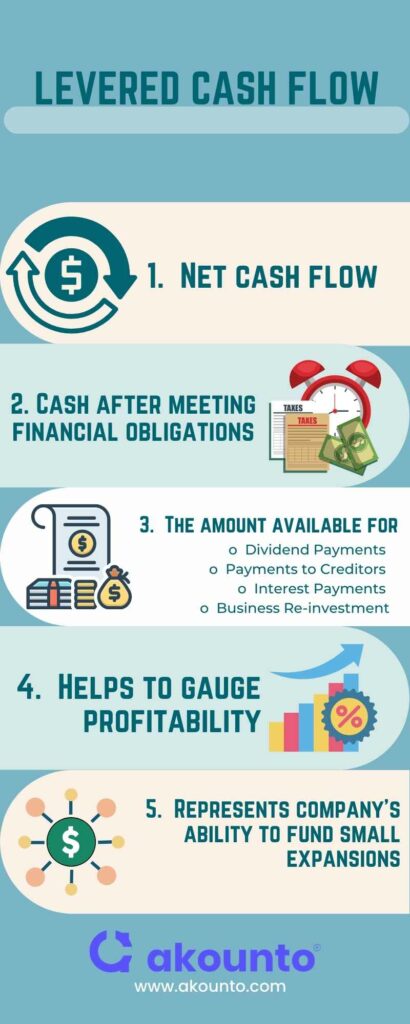What is Levered Free Cash Flow?
Levered free cash flow refers to a company’s net cash flow after paying all its short and long-term financial obligations like interest expenses, taxes, debts, etc. Levered free cash flow represents the amount available for shareholders and investment purposes.
[ez-toc]
Calculating levered free cash for a company is important as this is the amount available for a business to distribute dividends and make further investments.
Levered free cash flow (FCF) indicates the company’s financial health. Investors are interested in the LFCF to measure the company’s short-term liquidity. Some investors consider LFCF to measure a company’s true profitability.
Levered free cash flow, along with the operating cash flow, net income, and other current ratios, helps to assess the company’s liquidity position and financial performance.
The amount of cash generated by the company’s normal operations is called operating cash flow (OCF).
Cash flow calculations involve three main metrics:
- Levered free cash flow,
- Unlevered free cash flow, and
- Discounted cash flow
Let us briefly understand the important terminologies before proceeding further:
- Levered free cash flow is the net cash flow after meeting financial obligations. It is the amount available for dividend payments, payments to creditors, interest payments, business re-investment, etc. Many investors replace Earning Per Share (EPS) with Free Cash Flow per Share to gauge profitability after removing non-cash expenses from the Profit and Loss Statement.
- It shows the company’s ability to fund small expansions by using funds from operations and also offers the ability to raise funds via financing.
- Unlevered free cash flow: Unlevered cash flows are gross cash flows that represent money before paying for obligations. It is the net of working capital and capital expenditures. Unlevered cash flow calculation requires that all the non-cash expenses like depreciation are added back to the net income.
- Unlevevered cash flows are used in calculating discounted cash flow valuations where the debt servicing ability in highly leveraged transactions needs to be analyzed.
- Discounted cash flow: It is one method that helps businesses decide whether to invest in an asset, project, security, etc. Here the valuation of future cash flows is done and helps in comparing future cash flows generated against the investment undertaken in the present scenario.
The difference lies in how many financial obligations a company has. If financial obligations such as debt are subtracted from the cash flow statement, the cash flow is levered. If they are included, the cash flow is said to be unlevered.
This article talks in detail about the levered free cash flow, how it works, what it tells, and how it differs from the unlevered free cash flow.
How does Levered Free Cash Flow work?

Levered free cash flow is a better indicator for equity investors, lenders, and stakeholders as it transparently indicates a company’s profitability. A strong positive levered free cash flow LFCF shows a company’s ability to reinvest in new opportunities and pay returns to the stakeholders.
A negative LFCF may indicate all the negative things about a company’s overall financial performance or its ability to obtain additional capital. But there is a lot more to consider for that.
A negative LFCF may be a temporary condition where a business has just made significant capital investments for business growth. When they pay off the debt payments, the LFCF will come back to its real position.
Till the levered free cash flow turns positive, a company must have enough cash for its operating expenses and physical space rents. A negative levered free cash flow for a small business may also indicate that the firm has been built on borrowed capital.
When these small businesses get over their debt and accounts payable, the levered free cash flow will slowly turn to a healthy amount.
Capital assets, investments, and operating costs impact a company’s cash flow, resulting in a negative or positive LFCF. A company may be expanding and increasing its capital expenditures for future growth, which is when it will show a negative LFCF. But still, more than looking at the LFCF alone is needed to make an investment decision.
How to Calculate Levered Free Cash Flow?
Here is an example of calculating LFCF for a transportation company.
The company started three years ago with $300,000, out of which $200,000 were the borrowed capital. Each month $10,000 goes into debt. The company also bought operating equipment worth $200,000.
In the first year, the EBITDA was $155,000. That figure grew to $255,000 in the second and $300,000 in the third year. Here is what the working capital, capital expenditures, and debt payments of the company looked like for these three years:
| Year 1 | Year 2 | Year 3 | |
| EBITDA | $155,000 | $255,000 | $300,000 |
| CAPEX | $200,000 | $0 | $20,000 |
| Working capital | $50,000 | $100,000 | $200,000 |
| Mandatory debt payments | $120,000 | $120,000 | $120,000 |
According to the levered free cash flow formula:
LFCF = EBITDA – change in net working capital – CAPEX – mandatory debt payments
Now we’ll do the calculation for the first year:
LFCF = 155,000 – 50,000 – 200,000 – 120,000 = -$215,000
LFCF for the second year will be:
LFCF = 255,000 -50,000 – 0 – 120,000 = $85,000
And the third year:
LFCF = 320,000 – 100,000 – 20,000 – 120,000 = $80,000
What does the Levered Free Cash Flow Tell?
Levered free cash flow measures a company’s cash cushion, revenue generation, liquidity, and success of its operations. A positive levered cash flow indicates the company’s ability to pay dividends to the stakeholders and attract bigger investors. It also facilitates a company to obtain more capital from lenders for expanding the business.
Levered free cash flow LFCF considers all payables, taxes paid, and interest payments a business owes and then calculates the remaining cash. This revenue is the money left for growth, business expansion, raising more capital, paying the equity holders, releasing more company shares, and using better opportunities.
Levered Free Cash Flow vs. Unlevered Free Cash Flow
Both levered and unlevered free cash flows appear on the balance sheet.
The company’s net income, working capital, and interest payments decide whether the operating cash flow is positive or negative after the mandatory debt payments. And the levered free cash flow formula helps estimate the company’s ability to pay shareholders. On the other hand, the unlevered free cash flow shows a business’s actual earnings or revenue before accounting for any of its interest expenses or non-cash items.
Here is how the two differ from each other:
| Levered Free Cash Flow | Unlevered Free Cash Flow |
| Levered cash flow is the amount of money a business has after paying off its financial obligations. | Unlevered cash flow is a business’s gross free cash flow before paying off its debt obligations, interest expense, and operating expenses. |
| Levered free cash flow is the money available for a company to reinvest, raise more capital, and expand the business. | Unlevered free cash flow is the money available to pay the equity and debt holders. |
| Levered free cash flow accounts for non-cash expenses such as depreciation and amortization. | Unlevered cash flow adds the non-cash expenses back to earnings. |
| Levered free cash flow is a better indicator for investors and stakeholders, as it presents a better picture of whether a company is financially healthy. | Unlevered free cash flow is a more rosy number, as it is unlevered. It is not a better indicator than the LFCF for a company’s financial statements. |
Preparing and managing accurate financial statements is an expert accountant’s job. Akounto offers professional staff and the utmost accuracy for bookkeeping for your business so that you can outsource your accounting tasks to safe hands.




